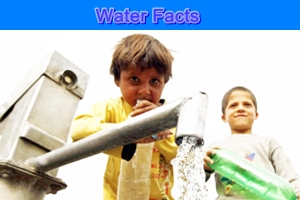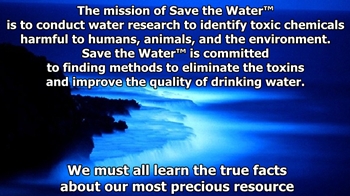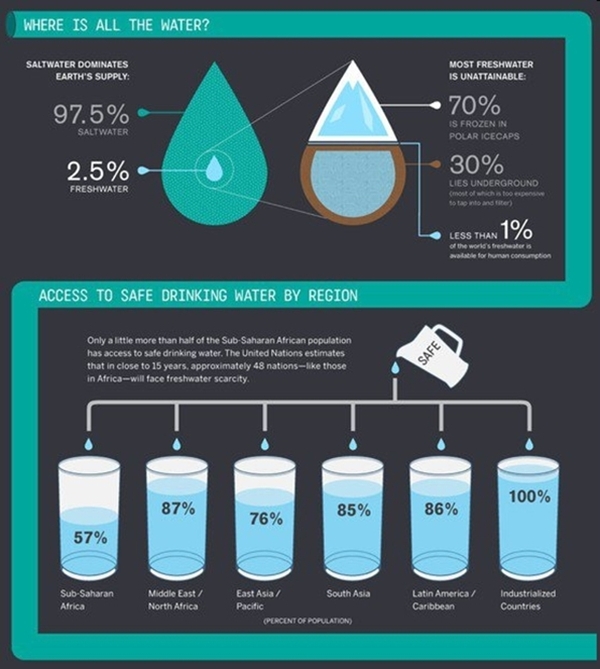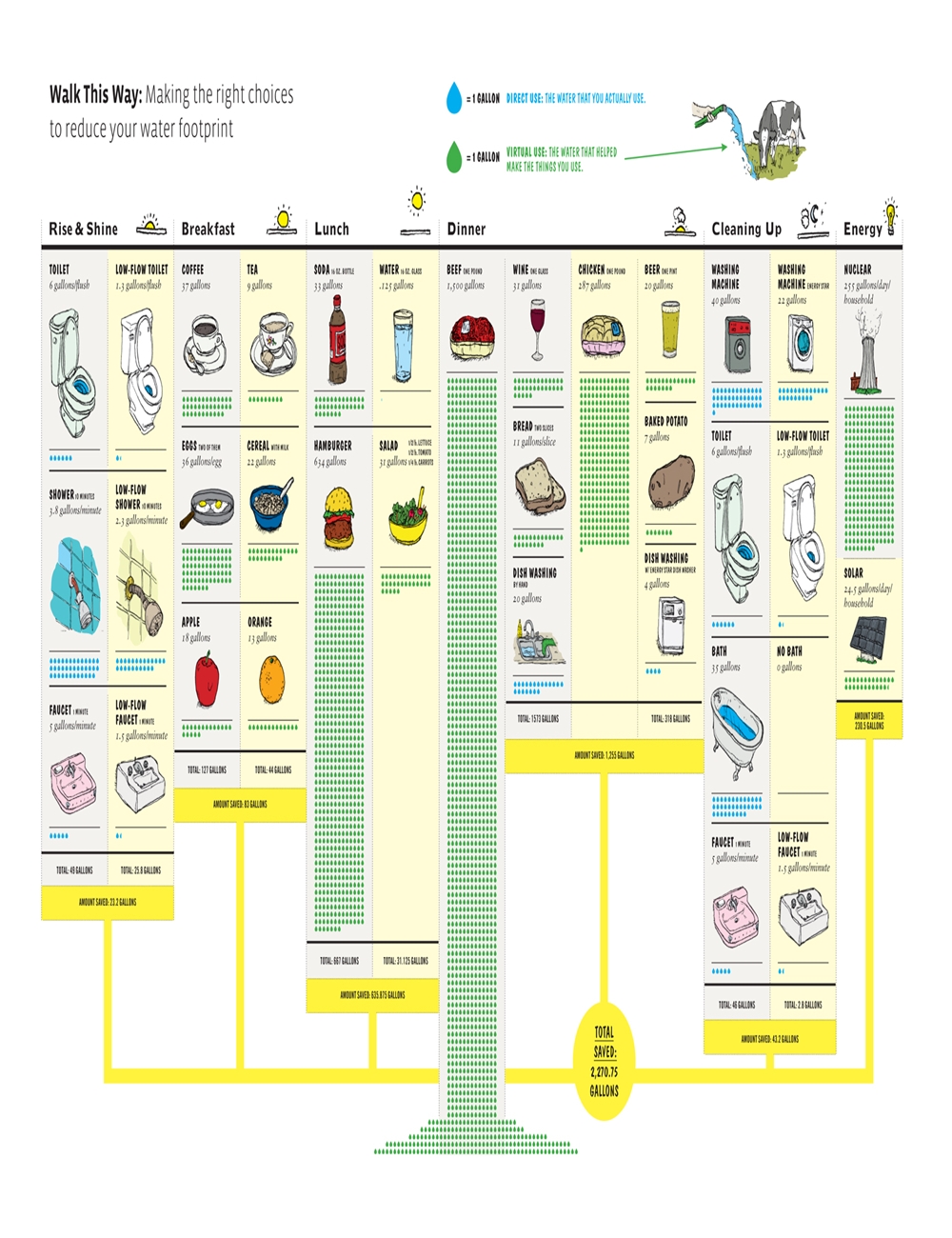Water Facts
Access to Safe Clean Healthy Water
• 75 % of our earth is covered with water yet 1.4 billion people live without clean drinking water.
• Two-fifths of the world’s population lack access to proper sanitation.
• More than one-third of Africa‚ population lacks access to safe drinking water.
• 97 % of earth’s water is in the oceans. Only 3 % of the earth’s water can be used as drinking water. 75 % of the world’s fresh water is frozen in the polar ice caps.
• More than 130 million people in Latin America and the Caribbean lack access to safe drinking water.
• Between 15 and 20 percent of the water used worldwide is not for domestic consumption, but rather for export .
• Three-quarters of the Earth’s surface is covered with water, yet 98 percent is salt water and not fit for consumption.
• Less than one percent of all the water on Earth is freshwater available for human consumption.
__________*
Water and Your Health
• Although a person can live without food for more than a month, a person can only live without water for approximately one week.
• The human body is more than 60 percent water. Blood is 92 percent water, the brain and muscles are 75 percent water, and bones are about 22 percent water.
• The average person needs 2 quarts of water a day.
• Water comprises more than 80% of your blood, and the brain and muscles are three-fourths water.
• 75% of Americans are chronically dehydrated.
• If you are thirsty your body is already dehydrated.
• Even mild dehydration will slow down one’s metabolism as much as 3%.
• Losing just 1-2% of your body weight in water causes a decrease in your performance of between 10-20%.
• A mere 2% drop in body water can trigger fuzzy short term memory, trouble with basic math, and difficulty focusing on the computer screen or a printed page.
• Diarrhea killed more children in the last decade, nearly 2 million a year in developing countries, than all armed conflicts since the Second World War.
• Dirty water kills more children than war, malaria, HIV/AIDS and traffic accidents combined.
• 75 percent of the people in Latin America and the Caribbean suffer from chronic dehydration because of poor water quality.
• Lack of water, the #1 trigger of daytime fatigue.
• On average it takes about 2 cups of water to make up for the dehydration caused by a single alcoholic drink or a cup of coffee.
• In 37% of Americans, the thirst mechanism is so weak that it is often mistaken for hunger.
• A healthy person can drink about three gallons (48 cups) of water per day.
• Preliminary research indicates that 8-10 glasses of water a day could significantly ease back and joint pain for up to 80% of sufferers.
• Drinking 5 glasses of water daily decreases the risk of colon cancer by 45%, plus it can slash the risk of breast cancer by 79% and one is 50% less likely to develop bladder cancer.
• At birth, water accounts for approximately 80 percent of an infant’s body weight.
• Water fights bad breath.
• One glass of water will shut down midnight hunger pangs.
• Approximately 70 percent of an adult’s body is made up of water.
• The main cause of kidney stones is dehydration.
• Daily recommended amount of water is eight cups per day, not all of this water must be consumed in the liquid form.
• The best treatment for dry eyes is drinking enough water throughout the day.
• Water helps your skin look better.
• 8-10 glasses a day is recommended for a sedentary person.
• A simple way to estimate water recommendation for a person who works out would be to multiply body weight times 0.55. Example: 180 pound person — 180 times 0.55 = 99 ounces of water per day.
• Drinking too much water too quickly can lead to water intoxication.
• Water intoxication is most likely to occur during periods of intense athletic performance.
• Caffeine can act as a mild diuretic, preventing water from traveling to necessary locations in the body.
• Nearly every food or drink item provides some water to the body.
• Every eight seconds a child dies from drinking dirty water.
• Half of the world‚ hospital beds are occupied by people with an easily preventable waterborne disease.
• 80 percent of all sickness and disease worldwide is related to contaminated water.
Top of Water Facts
__________*
Water Quality Scarcity and Problems
• 90 percent of wastewater produced in underdeveloped countries is discharged untreated into local waters.
• The Safe Drinking Water Act (SDWA) of 1974 represents the first time that public drinking water supplies were protected on a federal (national) level in the United States. Amendments were made to the SDWA in 1986 and 1996.
• 80 of China‚ major rivers are so degraded that they no longer support aquatic life.
• 90 percent of all groundwater systems under major cities in China are contaminated.
• 75 percent of India‚ rivers and lakes are so polluted that they should not be used for drinking or bathing.
• 60 percent of rural Russians drink water from contaminated wells.
• 20 percent of all surface water in Europe is seriously threatened.
• An estimated 2.4 billion people lack adequate sanitation and 1.1 billion people are without access to safe water.
• 90 percent of wastewater in developing countries is discharged into rivers and streams without any treatment.
• There are 1.6 million deaths per year attributed to dirty water and poor sanitation.
• One-third of the world‚ population lives in water stressed countries now.
• Unless we change our ways, two-thirds of the world‚ population will face water scarcity by 2025.
• The percentage of the Earth‚ land area stricken by serious drought more than doubled between the 1970s and 2005.
• Sources of water pollution include: oil spills, fertilizer and agricultural run-off, sewage, storm water, and industrial wastes.
• The average distance that women in developing countries walk to collect water per day is four miles and the average weight that women carry on their heads is approximately 44 pounds.
• 90 percent of the Europe‚ alpine glaciers are in retreat.
• Over 40 billion work hours are lost each year in Africa to the need to fetch drinking water.
• Each day almost 10,000 children under the age of 5 in Third World countries die as a result of illnesses contracted by use of impure water.
• Most of the 3rd world’s people must walk at least 3 hours to fetch water.
• On a global average, most freshwater withdrawls—69%—are used for agriculture, while industry accounts for 23% and municipal use (drinking water, bathing and cleaning, and watering plants and grass) just 8%.
• Of the 1200 species listed as threatened or endangered, 50% depend on rivers and streams.
• Compared today, five times as much land is likely to be under ‚extreme” drought by 2025.
• One fifth of the world’s freshwater fish—2,000 of 10,000 species identified—are endangered, vulnerable, or extinct. In North America, the continent most studied, 67% of all mussels, 51% of crayfish, 40% of amphibians, 37% of fish, and 75% of freshwater mollusks are rare, imperiled, or already gone.
• At least 123 freshwater species became extinct during the 20th century. These include 79 invertebrates, 40 fishes, and 4 amphibians. (There may well have been other species that were never identified.)
• More than two-thirds of Chinese cities face water shortages.
• Rapid melting will reduce the Tibetan glaciers by 50 percent every decade.
Top of Water Facts
__________*
|
Water: Your Home and Family
• The average person in the United States uses 80 to 100 gallons of water each day. During medieval times a person used only 5 gallons per day.
• About 1.2 billion gallons of potable water are used in New Jersey each day.
• The average American household consumes about 127,400 gallons of water during a year. Homeowners in Washington, DC, pay about $350 for that amount of water. Buying that same amount of water from a vendor in Guatemala City would cost more than $1,700.
• 3.9 trillion gallons of water are consumed in the United States per month.
• Average American uses 176 gallons of water per day compared to 5 gallons of water the average African family uses each day.
• The average single-family home uses 80 gallons of water per person each day in the winter and 120 gallons in the summer.
• Showering, bathing and using the toilet account for about two-thirds of the average family’s water usage.
• 6.8 Billion — Gallons of water Americans flush down their toilets every day.
• About 6,800 gallons of water is required to grow a day’s food for a family of four.
• The average American consumes 1,500 pounds of food each year; 1,000 gallons of water are required to grow and process each pound of that food—1.5 million gallons of water is invested in the food eaten by just one person! This 200,000-cubic-feet-plus of water-per-person would be enough to cover a football field four feet deep.
• About 39,090 gallons of water is needed to make an automobile, tires included.
• It takes about 6 gallons of water to grow a single serving of lettuce. More than 2,600 gallons is required to produce a single serving of steak.
• It takes almost 49 gallons of water to produce just one eight-ounce glass of milk. That includes water consumed by the cow and to grow the food she eats, plus water used to process the milk.
• At least 9.6 million households and $390 billion in property lie in flood prone areas in the United States. The rate of urban growth in floodplains is approximately twice that of the rest of the country.
• Water used around the house for such things as drinking, cooking, bathing, toilet flushing, washing clothes and dishes, watering lawns and gardens, maintaining swimming pools, and washing cars accounts for only 1% of all the water used in the U.S. each year.
Top of Water Facts
__________*
Water Trivia
• It takes about 1 gallon of water to process a quarter pound of hamburger.
• It takes 2,072 gallons of water to make four new tires.
• The first United States water plant with filters was built in 1872 in Poughkeepsie, New York.
• In 1908, Jersey City, New Jersey and Chicago, Illinois were the first water supplies to be chlorinated in the United States.
• Water intoxication occurs when water dilutes the sodium level in the bloodstream and causes an imbalance of water in the brain.
• In the 1950’s scientists began to suspect that water might carry diseases. Although earlier treatment of water could make the water safer, it was mainly done to improve the taste, smell or looks of the water. One gallon of water is equal to 3.785 liters of water. The overall amount of water on our planet has remained the same for two billion years.
• The United States consumes water at twice the rate of other industrialized nations.
• One cubic foot of water is equal to 7.48 gallons of water.
• Water boils at 212o Fahrenheit or 100o Celsius.
• Ancient Egyptians treated water by siphoning water out of the top of huge jars after allowing the muddy water from the Nile River to settle
• At any one time, it is estimated that half the world’s hospital beds are occupied with patients suffering from waterborne diseases. Average amount of pesticides used per acre, per year, on golf courses: 18 pounds
• Average amount of pesticides used, per acre, per year, in agriculture: 2.7 pounds.
• Amount of water used by 60,000 villagers in Thailand, on average, per day: 6,500 cubic meters.
• Amount of water used by one golf course in Thailand, on average, per day: 6,500 cubic meters.
• Most of the earth’s surface water is permanently frozen or salty.
• Approximately 70% of the world’s supply of fresh water is located in Antarctica, locked in 90% of the world’s ice. (Source: Gulf of Maine Research Institute)
• The earth’s total allotment of water has a volume of about 344 million cubic miles. Of this:
o 315 million cubic miles (93%) is sea water!
o 9 million cubic miles (2.5%) is in aquifers deep below the earth’s surface.
o 7 million cubic miles (2%) is frozen in polar ice caps.
o 53,000 cubic miles of water pass through the planet’s lakes and streams.
o 4,000 cubic miles of water is atmospheric moisture.
o 3,400 cubic miles of water are locked within the bodies of living things.
o Water freezes at 32o Fahrenheit or 0o Celsius.
• During the 20th century, water use increased at double the rate of population growth; while the global population tripled, water use per capita increased by six times.
Top of Water Facts
__________*
US Water Contaminant Facts
US Water Contaminant Facts
• “US drinking water contains more than 2100 toxic chemicals that can cause cancer”
• “Residues of 39 pesticides and their degradation products have been detected in the ground water of 34 states”
• “The fact is today in our industrialized society we use over 75,000 toxic chemicals and over 1000 new ones are developed each year. We have learned the hard way that any chemical we use will eventually wind up in the water we drink. There is no “new” water…”
• “35% of the reported gastrointestinal illnesses among tap water drinkers were water related and preventable”. “Each year in the US, lead in drinking water contributes to 480,000 cases of learning disorders in children and 560,000 cases of hypertension in adult males”
• “More than 45 million Americans drank water supplied by systems where the unregulated and potentially deadly contaminant Cryptosporidium was found in their raw or treated water”
• Top of Water Facts
|








